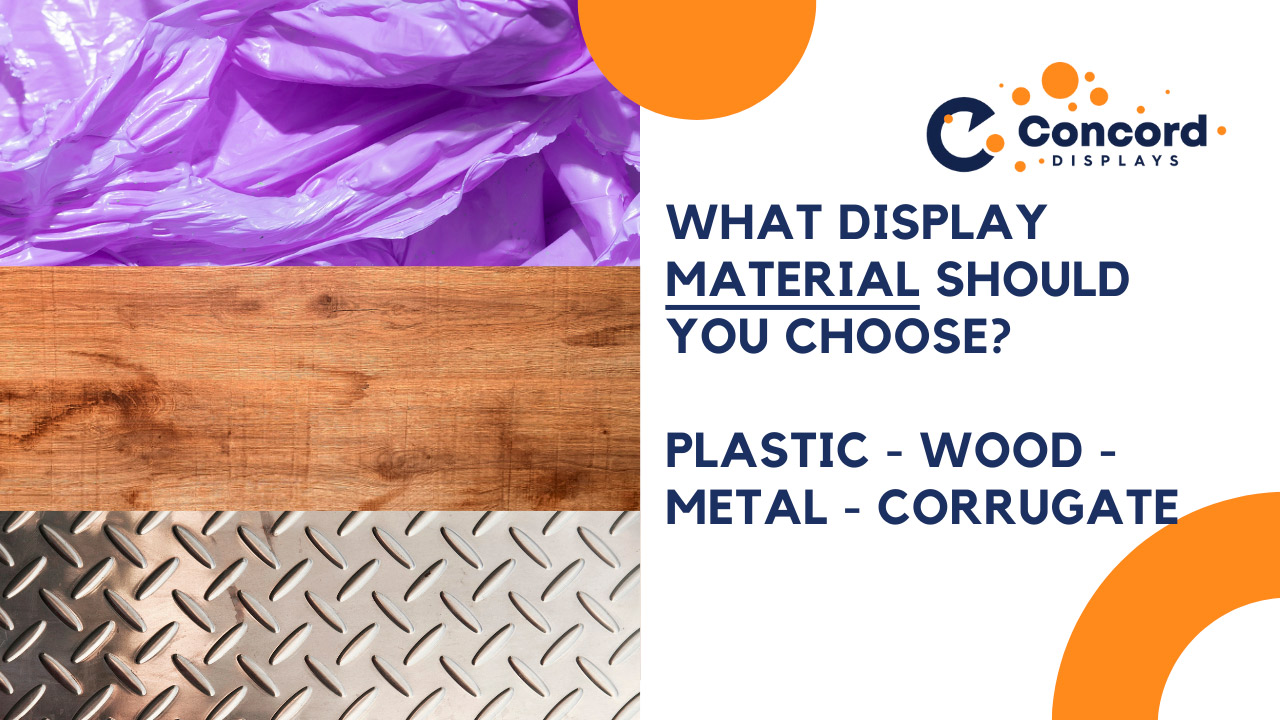Do you have a great vision for a POP display for your product, but are not sure what display material it should be made of? Or maybe you’ve always ordered POP displays in plastic, but wonder what the advantages of wood, metal, or corrugate are. In this blog, I’ll break down the different types of materials displays can be made of, and explain the advantages and disadvantages of each. You’ll be equipped to know exactly what you want from your next display order!
Plastic displays
Out of the four materials, this is the most expensive material per square inch or foot. The raw material is a petroleum base material, which means the sheet prices go up and down with oil prices, “like the wind.”
There are many plastics we work with, including acrylic, styrene, PVC, ABS, and PTEG. Each type is for a different application, which means plastic is a very versatile material that can do a variety of things. For example, we normally use styrene to print on for display headers and side panels. Since acrylic can be clear or different colors, it’s great for any display that needs a clear section or specific colors. We use it a lot for counter displays. Acrylic is considered the Cadillac of plastics, and a lot of make-up displays are made of this material.
The great thing about plastic is it can be heated and bent very easily to make curvy shapes at many different angles. So think about plastic if you’re looking for a curvy display!

Wood displays
Wood is a material I have a lot of experience with, since in my early career I worked at a wood display factory. We did a lot of displays made of MDF (medium-density fiber board). MDF is condensed wood chips which make sheets of material ½” to ¾” thick 4ft. wide by 8ft. long. This material can also be used for a variety of things. It can be used to cut flat shapes, glue laminate on for wood grains and special colors, or painted for many more colors. This board is very heavy and strong. It’s used a lot for the end caps in grocery stores to hold heavy products or lots of products.
There are also hardwoods like oak and alder that are very strong and already have the wood grain look. I have used these a lot when a customer is looking for something like a Mexico old-style cart or wood crates. This material is mostly used to do displays with straight lines, and not displays with curved lines.

Metal displays
Under the heading of metal displays, we have several subtypes. We have wire, tubing and sheet metal. Wire can be bent in all directions, and it helps keep the weight down compared to sheet metal. Wire is often used when making shelves. Tubing helps to create a strong structure for the sides and back of the display. Sheet metal is used for price channels, headers or side panels add-ins, and it can be lasered with images or logos. A lot of shelves are made of sheet metal because the product is so light. This means a sheet metal shelf doesn’t need to be very thick, as thick shelves would make a display heavy.
We design a lot of displays with all three metal subtypes because they all work very well for a specific purpose and work well together.
It’s also possible to put colors on metal, either by a process called powder coating, or by a plating process. Powder coating used to be limited in what colours you could have—black, white, gray, and almond. But now we have many colors and finishes, so color is no longer a major limitation when it comes to metal displays!

Corrugate displays
Corrugate is the least expensive raw material out there. Think of the material a flat box is made of. Making cuts, die cuts, folds and printing with corrugated material are the techniques used to create displays out of corrugate. Corrugate is for a high volume of displays: many thousands to tens of thousands. Tooling can be very expensive depending on the complexity.
Corrugate has come a long way over the last 15 years. Displays can be tripled-walled and folded over more than once to hold heavier products.
This type of display is normally what we call a throw-away. They use up the product in the display and then order a new one, or in a lot of cases, the program is done at that point. There normally only used for 2-4 months at retail. So keep the length of time it will be used in mind when considering what display material to use.
***
This should equip you to know exactly what you want from your next display order, and what display material to use! These were the different types of materials displays can be made of—plastic, wood, metal and corrugate—and the advantages and disadvantages of each. Talk to us here at Concord Displays if you have any questions! We love creating custom displays that are exactly right for your product.
You can reach us at info@concorddisplays.com or 626.824.3776.
About Concord Displays
Concord Displays is your single-source partner for in-store merchandising, POP displays and retail signage. We have thirty years of exceeding client expectations by delivering impactful POP display design and manufacturing service at a surprisingly affordable price.


